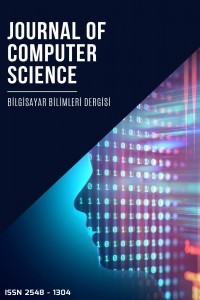IPS Sistemlerde Yapay Zekânın Son Beş Yıldaki Gelişimi
yapay zeka, makine öğrenmesi, siber güvenlik, IPS
The Development ff Artıfıcıal Intellıgence in IPS Systems in The Last Five Years
machine learning, cyber security, artificial intelligence., IPS,
___
- Borman, K. (2019). Datacenter ıntrusion prevention system test report. texas: NSS laps.
- Buduma, N., & Locascio, N. (2017). Fundamentals of deep learning: designing next-generation. O'Reilly media.
- Costa, C. F. (2021). Artificial ıntelligence & cybersecurity: european union panorama. societa ıtaliana per ı'l organizzazione ınternazionale. pedralva.
- Cyberedge. (2022). Cyberthreat defense report. NewYork: cyber edge research labs.
- Das, S., & Nene, M. J. (2017). A survey on types of machine learning techniques in ıntrusion prevention systems. ıeee wispnet 2017. ıeee.
- ENISA. (2018). Cybersecurity culture guidelines: behavioral aspects of cybersecurity. enısa. doi:doı: 10.2824/324042
- EPRI. (2020). Cyber security road map. california: eprı.
- Fortinet. (2022). Investor presentation. amsterdam: fortinet labs.
- Marinos, L., Lourenco, M. B. (2020). Main incidents in the eu and worldwide enısa threat landscape. enısa.
- Micro, T. (2017). Machine learning and ngıps. ABD
- Patel, A., Qassim, Q., & Wills, C. (2010). Ids and ıps research. ınformation and computer security.
- Qu, S., Li, X., Szurley, J., Kolter, J. Z., & Metze, F. (2019). Adversarial music: real-world audio adversary against wake-word detection system. 2019. Vancouver: neurıps.
- Scarfone, K., & Mell, P. (2007). Guide to ıntrusion detection and prevention system. gaithersburg: nıst.
- Shokri, R., Stronati, M., Song, C., & Shmatikov, V. (2017). Membership ınference attacks against machine learning models. güvenlik ve gizlilik sempozyumu (s. 3-18). ıeee.
- Tolido, R., Frank, A., Delabarre, L., & Cherian, S. (2020). Reinventing cybersecurity with artificial intelligence: the new frontier in digital security. amsterdam: capgemini researchınstitute.
- Aslan, F. (2022, Nisan 14). iskulubu. https://iskulubu.com/manset/yapay-zekanin-en-onemli-5-avantaji-ve-dezavantaji/ Cimpanu, C. (2020, Ekim 17).
- https://www.zdnet.com/article/first-death-reported-following-a-ransomware-attack-on-a-german-hospital/iisbf gelisim haber. (2021).
- https://iisbf.gelisim.edu.tr/bolum/isletme-37/haber/stanford-universitesi-2021-yili yapay-zeka-raporu-yayimlandi McElfresh, M. (2016).https://theconversation.com/cyberattack-on-ukraine-grid-heres-how-it-worked-and-perhaps-why-it-was-done-52802
- Voss RF, Clarke J. (1986) Algorithmic Musical Composition, Silver Burdett Press, London.
- Zabierowski W, Napieralski A (2003) Chords classification in tonal music. Journal of Environment Studies 10(5): 50-53.
- Abiewskiro A, Moplskiiera Z. (2008) The Problem Of Grammar Choice For Verification. TCSET of the International Conference, House of Lviv Polytechnic National University, pp.19-23.
- Healthwise Knowledgebase (1998) US Pharmacopeia, Rockville. http://www.healthwise.org. Accessed 21 Sept 1998
- ISSN: 2548-1304
- Yayın Aralığı: Yılda 2 Sayı
- Başlangıç: 2016
- Yayıncı: Ali KARCI
Novel Machine Learning (ML) Algorithms to Classify IPv6 Network Traffic in Resource-Limited Systems
Yıldıran YILMAZ, Selim BUYRUKOĞLU, Muzaffer ALIM
Denim Kumaşından Otomatik Yüksek Çözünürlüklü Bıyık Desen Sentezi
Emrullah ŞAHİN, Muhammed Fatih TALU
Pupil Center Localization Based on Mini U-Net
Derin Öğrenme Tabanlı Görüntü İşleme İle Acil Durum Tespiti
Mustafa GÖKSU, Şafak GÖKSU, Ahmet ALKAN
5G Sistemleri için DL Tabanlı Kanal Tahmini
Jansen Bağlantısının Kinematik Analizi için Araç Kutusu Tasarımı
Semir SÜNKÜN, Berke Oğulcan PARLAK, Alper YILDIRIM, Hüseyin Ayhan YAVAŞOĞLU
Ecem BÖLÜK, Mustafa Özgür CİNGİZ
Analysis of Memcapacitor Based Low Pass Filter
Feras DAHROUJ, Sevgi GÜRSUL, Serdar Ethem HAMAMCI
Beyin Tümörü Bölütleme ve Algılamada Yeni Çekişmeli Üretken Ağ Kullanılması
